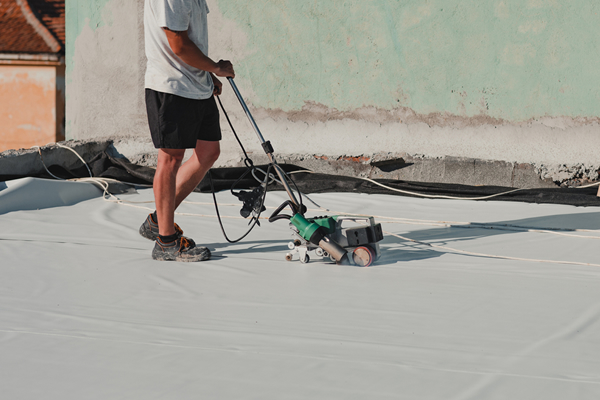Using Induction Welding Techniques to Speed Up TPO Single-Ply Applications: A Case Study From Colorado
Author: Michael Russo | April 15, 2021
It's been almost 10 years since contractor Colorado Moisture Control Inc. (CMC) of Denver conquered a 450,000 square-foot, Goliath-size commercial roofing project — quickly and cost-effectively — using its secret weapon: the RhinoBond non-penetrating fastening system featuring induction welding techniques.

Since that time, induction welding of thermoplastic polyolefin (TPO) single-ply roof membranes have become much more common.
RhinoBond is an insulation and membrane attachment option that uses the same fastener and plate to secure the roof membrane and the insulation to the roof deck without penetrating the roofing material. If you haven't yet learned how to install this system, you should consider adding it to your skillset.
The Latest in Induction Welding Techniques
The Drill-Tec XHD Plate is a key element to CMC's system. The plate is made of Galvalume steel with a special TPO coating. After installing the insulation to the deck, the roofing applicator activates the electromagnetic induction welding tool directly over the specially coated plate to bond the underside of the membrane to the plate.
The heating process takes about five seconds, depending on ambient temperature, membrane thickness and power source. A weighted magnetic cooling clamp is then placed on the welded plate for 60 seconds to ensure a strong bond.
If your membrane roofing project is not using the Rhinobond system, TRI-BUILT Galvalume plates may also be an option.
Using Induction Welding Techniques to Increase Wind Uplift Resistance
While discussing the 450K square-foot project, CMC operations manager Rich Cohen noted, "The induction welding of the TPO to the fastening plates beneath the membrane — and the fasteners' uniform location throughout the system — solves the problem of membrane fluttering, and high winds were definitely a concern on a roof this large."
In fact, the company used eight fasteners per insulation board instead of the usual six fasteners to comply with local code requirements on the 333 Centennial building in Louisville, CO, a few miles southeast of Boulder.
"What we liked about this system is the fastening pattern distributes wind uplift forces more evenly across the membrane, rather than putting the stress on one fastener every 10 feet in the seam," said Cohen.
"We basically had a fastener every two feet in every direction," he explained. "So, we felt the new roof wouldn't be as prone to wind damage as a mechanically attached system with fasteners every 10 feet in the seam."
Cohen specified a 60 mil TPO membrane for the project.
Meeting the Toughest Factory Mutual Standards
The induction welded system has been tested to meet Factory Mutual 1-90 and 1-120 wind uplift standards and doesn't depend on insulation thickness to enhance wind performance.
In contrast, when using a fully adhered application, the thinner the insulation layers are, the more fasteners you'll need to get the same amount of wind uplift resistance.
What's more, there is no need for in-seam fastening (typically 12" o.c.), and the widest sheets available from the roofing manufacturer can be used without the need for labor-intensive half sheets around the perimeter of the roof.
"You just fasten at the required rate, roll out the widest sheets, and weld," said Cohen.
Speeding Installations in Inclement Weather
During wet weather, the roof can also be dried-in faster by spot welding with the induction welding tool before the crew leaves the roof.
CMC's roofing crew was able to tack down the TPO sheet using induction welding techniques and then finish the fastening of the sheet the next day.
"We had one crew screwing down insulation and rolling out the membrane, while two other installers went back to ensure all the induction welds had been completed," Cohen noted.
After the special plate was welded and the machine was moved forward, Cohen had a roofer mark each plate with red crayon. This made it easier for non-welded plates to be spotted during in-progress inspections.
A Clean Machine
One thing Cohen was careful about was keeping the bottom surface of the induction welder clean. The magnet on the tool gives it its compression ability, and if small shards of metal or other debris stick to it, the membrane can be pierced. To prevent this problem, Cohen's crew cleaned the machine twice a day.
"We really had no issues with welding or adjusting the machine properly," he said. "The more experienced the operator is, the more efficient they can be."
While it's possible to install up to 100 squares of roofing a day with this system, Cohen's 10-person crew was slowed down by equipment screens.
However, after these details were flashed in, the company installed almost half a million square feet of TPO in record time.